CRISPR Gene Editing
VerifiedAdded on 2023/03/30
|9
|1979
|467
AI Summary
This essay provides an overview of CRISPR gene editing, including its process, location, usage in medicine, and the pros and cons of clinical trials. It discusses the potential of CRISPR/Cas9 in targeted gene editing and its applications in various fields. The essay also highlights the recent patents related to CRISPR technology. Find detailed study material on CRISPR gene editing on Desklib.
Contribute Materials
Your contribution can guide someone’s learning journey. Share your
documents today.

Running head: ESSAY
CRISPR gene editing
Name of the Student
Name of the University
Author Note
CRISPR gene editing
Name of the Student
Name of the University
Author Note
Secure Best Marks with AI Grader
Need help grading? Try our AI Grader for instant feedback on your assignments.
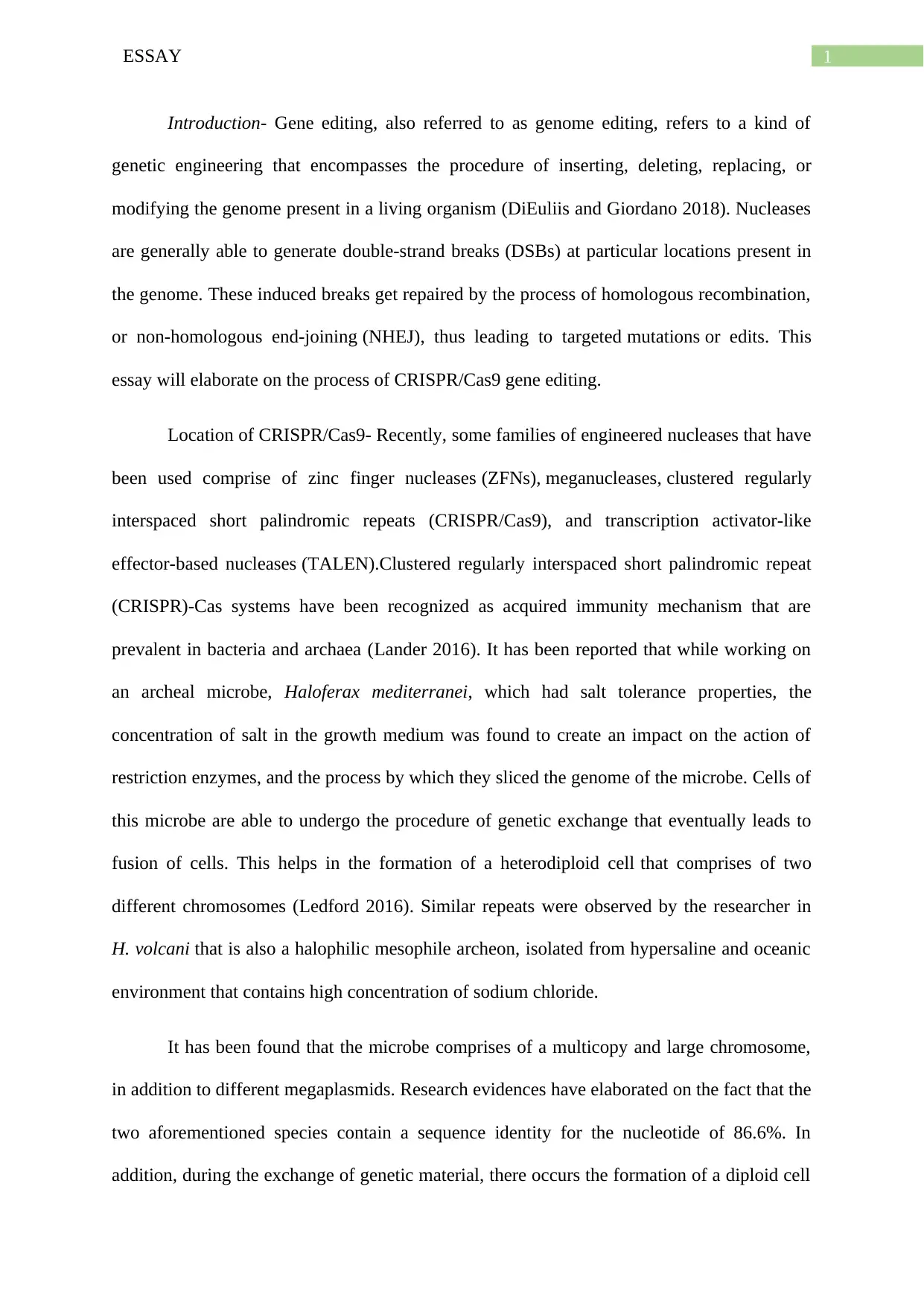
1ESSAY
Introduction- Gene editing, also referred to as genome editing, refers to a kind of
genetic engineering that encompasses the procedure of inserting, deleting, replacing, or
modifying the genome present in a living organism (DiEuliis and Giordano 2018). Nucleases
are generally able to generate double-strand breaks (DSBs) at particular locations present in
the genome. These induced breaks get repaired by the process of homologous recombination,
or non-homologous end-joining (NHEJ), thus leading to targeted mutations or edits. This
essay will elaborate on the process of CRISPR/Cas9 gene editing.
Location of CRISPR/Cas9- Recently, some families of engineered nucleases that have
been used comprise of zinc finger nucleases (ZFNs), meganucleases, clustered regularly
interspaced short palindromic repeats (CRISPR/Cas9), and transcription activator-like
effector-based nucleases (TALEN).Clustered regularly interspaced short palindromic repeat
(CRISPR)-Cas systems have been recognized as acquired immunity mechanism that are
prevalent in bacteria and archaea (Lander 2016). It has been reported that while working on
an archeal microbe, Haloferax mediterranei, which had salt tolerance properties, the
concentration of salt in the growth medium was found to create an impact on the action of
restriction enzymes, and the process by which they sliced the genome of the microbe. Cells of
this microbe are able to undergo the procedure of genetic exchange that eventually leads to
fusion of cells. This helps in the formation of a heterodiploid cell that comprises of two
different chromosomes (Ledford 2016). Similar repeats were observed by the researcher in
H. volcani that is also a halophilic mesophile archeon, isolated from hypersaline and oceanic
environment that contains high concentration of sodium chloride.
It has been found that the microbe comprises of a multicopy and large chromosome,
in addition to different megaplasmids. Research evidences have elaborated on the fact that the
two aforementioned species contain a sequence identity for the nucleotide of 86.6%. In
addition, during the exchange of genetic material, there occurs the formation of a diploid cell
Introduction- Gene editing, also referred to as genome editing, refers to a kind of
genetic engineering that encompasses the procedure of inserting, deleting, replacing, or
modifying the genome present in a living organism (DiEuliis and Giordano 2018). Nucleases
are generally able to generate double-strand breaks (DSBs) at particular locations present in
the genome. These induced breaks get repaired by the process of homologous recombination,
or non-homologous end-joining (NHEJ), thus leading to targeted mutations or edits. This
essay will elaborate on the process of CRISPR/Cas9 gene editing.
Location of CRISPR/Cas9- Recently, some families of engineered nucleases that have
been used comprise of zinc finger nucleases (ZFNs), meganucleases, clustered regularly
interspaced short palindromic repeats (CRISPR/Cas9), and transcription activator-like
effector-based nucleases (TALEN).Clustered regularly interspaced short palindromic repeat
(CRISPR)-Cas systems have been recognized as acquired immunity mechanism that are
prevalent in bacteria and archaea (Lander 2016). It has been reported that while working on
an archeal microbe, Haloferax mediterranei, which had salt tolerance properties, the
concentration of salt in the growth medium was found to create an impact on the action of
restriction enzymes, and the process by which they sliced the genome of the microbe. Cells of
this microbe are able to undergo the procedure of genetic exchange that eventually leads to
fusion of cells. This helps in the formation of a heterodiploid cell that comprises of two
different chromosomes (Ledford 2016). Similar repeats were observed by the researcher in
H. volcani that is also a halophilic mesophile archeon, isolated from hypersaline and oceanic
environment that contains high concentration of sodium chloride.
It has been found that the microbe comprises of a multicopy and large chromosome,
in addition to different megaplasmids. Research evidences have elaborated on the fact that the
two aforementioned species contain a sequence identity for the nucleotide of 86.6%. In
addition, during the exchange of genetic material, there occurs the formation of a diploid cell
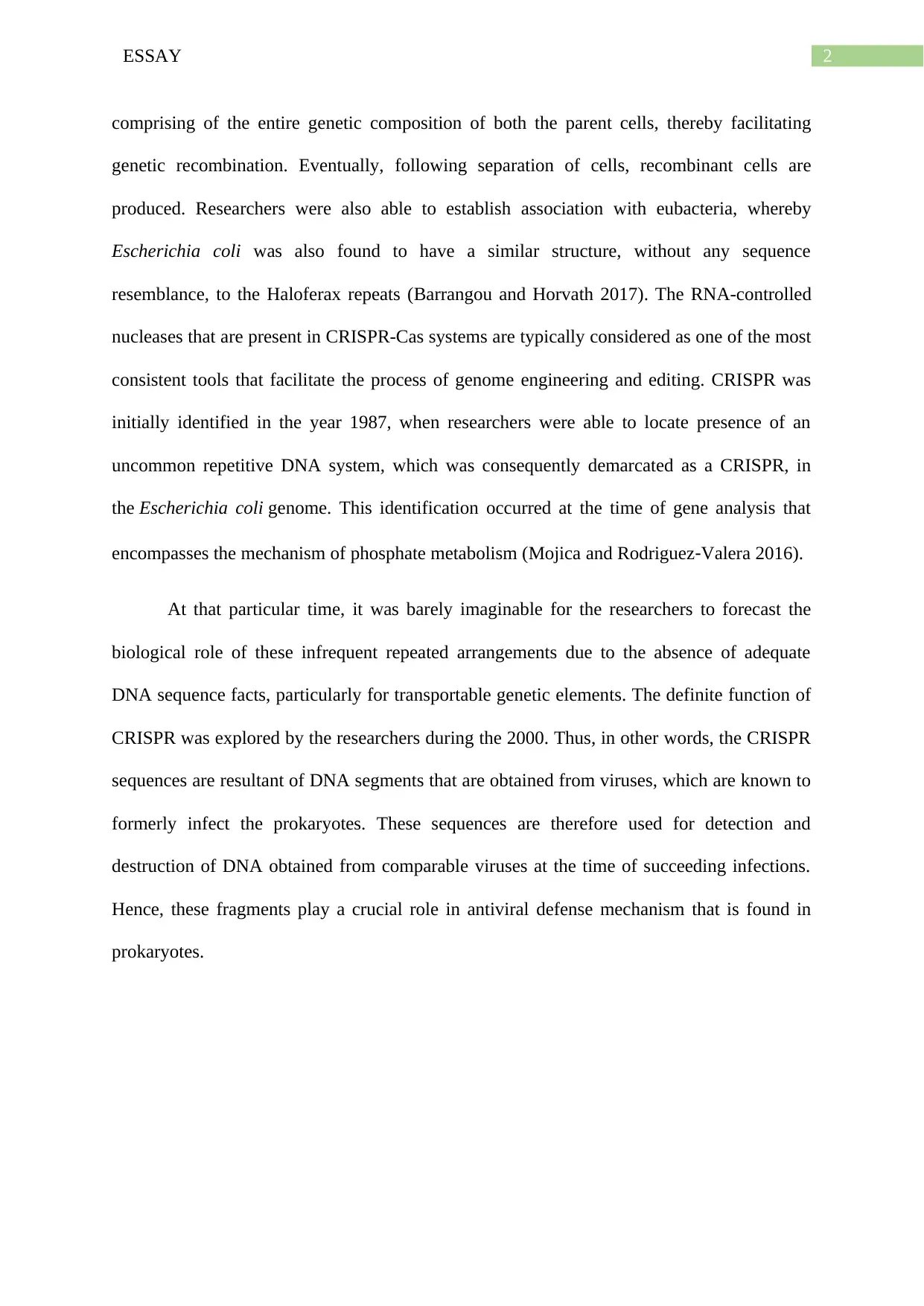
2ESSAY
comprising of the entire genetic composition of both the parent cells, thereby facilitating
genetic recombination. Eventually, following separation of cells, recombinant cells are
produced. Researchers were also able to establish association with eubacteria, whereby
Escherichia coli was also found to have a similar structure, without any sequence
resemblance, to the Haloferax repeats (Barrangou and Horvath 2017). The RNA-controlled
nucleases that are present in CRISPR-Cas systems are typically considered as one of the most
consistent tools that facilitate the process of genome engineering and editing. CRISPR was
initially identified in the year 1987, when researchers were able to locate presence of an
uncommon repetitive DNA system, which was consequently demarcated as a CRISPR, in
the Escherichia coli genome. This identification occurred at the time of gene analysis that
encompasses the mechanism of phosphate metabolism (Mojica and Rodriguez‐Valera 2016).
At that particular time, it was barely imaginable for the researchers to forecast the
biological role of these infrequent repeated arrangements due to the absence of adequate
DNA sequence facts, particularly for transportable genetic elements. The definite function of
CRISPR was explored by the researchers during the 2000. Thus, in other words, the CRISPR
sequences are resultant of DNA segments that are obtained from viruses, which are known to
formerly infect the prokaryotes. These sequences are therefore used for detection and
destruction of DNA obtained from comparable viruses at the time of succeeding infections.
Hence, these fragments play a crucial role in antiviral defense mechanism that is found in
prokaryotes.
comprising of the entire genetic composition of both the parent cells, thereby facilitating
genetic recombination. Eventually, following separation of cells, recombinant cells are
produced. Researchers were also able to establish association with eubacteria, whereby
Escherichia coli was also found to have a similar structure, without any sequence
resemblance, to the Haloferax repeats (Barrangou and Horvath 2017). The RNA-controlled
nucleases that are present in CRISPR-Cas systems are typically considered as one of the most
consistent tools that facilitate the process of genome engineering and editing. CRISPR was
initially identified in the year 1987, when researchers were able to locate presence of an
uncommon repetitive DNA system, which was consequently demarcated as a CRISPR, in
the Escherichia coli genome. This identification occurred at the time of gene analysis that
encompasses the mechanism of phosphate metabolism (Mojica and Rodriguez‐Valera 2016).
At that particular time, it was barely imaginable for the researchers to forecast the
biological role of these infrequent repeated arrangements due to the absence of adequate
DNA sequence facts, particularly for transportable genetic elements. The definite function of
CRISPR was explored by the researchers during the 2000. Thus, in other words, the CRISPR
sequences are resultant of DNA segments that are obtained from viruses, which are known to
formerly infect the prokaryotes. These sequences are therefore used for detection and
destruction of DNA obtained from comparable viruses at the time of succeeding infections.
Hence, these fragments play a crucial role in antiviral defense mechanism that is found in
prokaryotes.
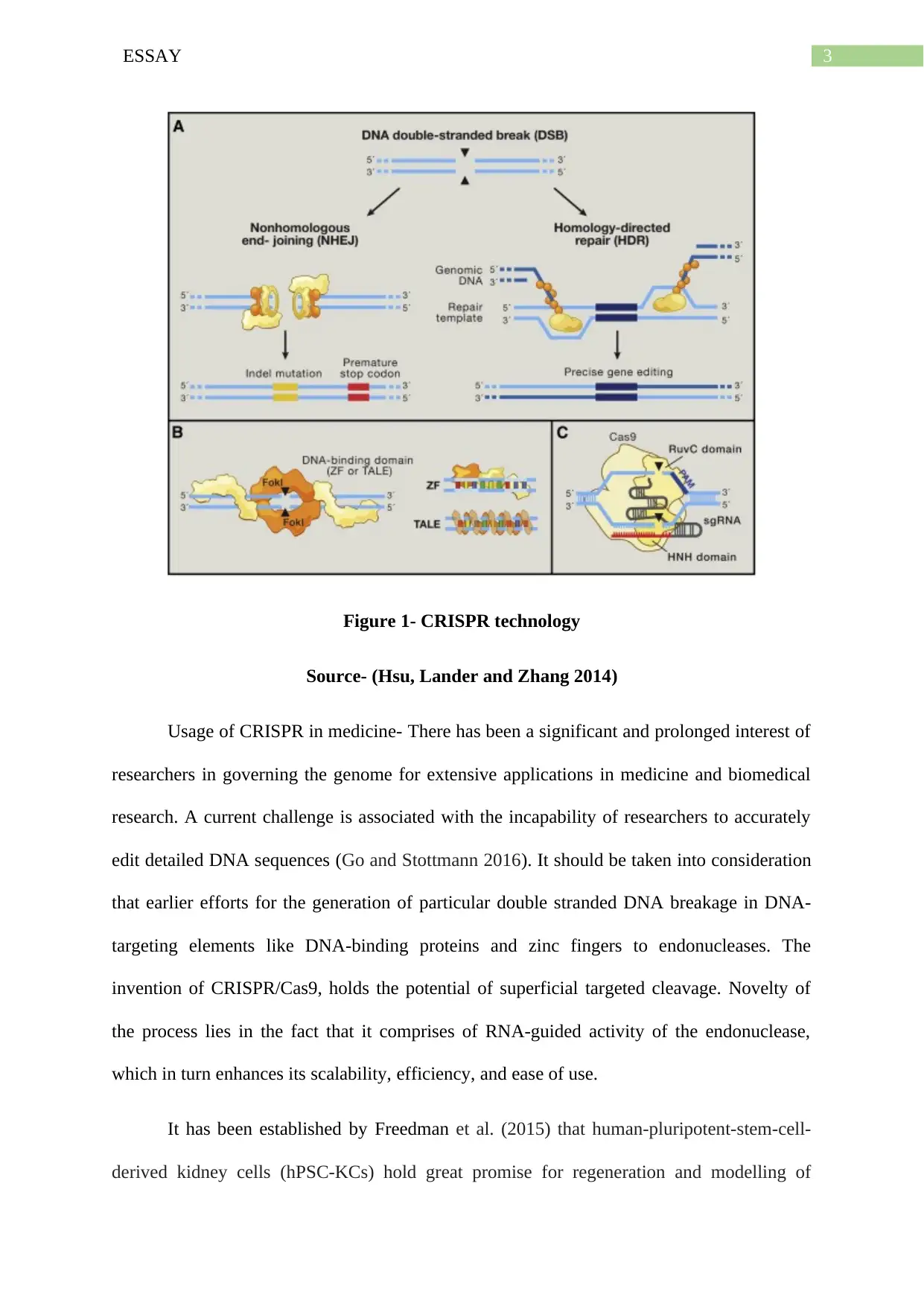
3ESSAY
Figure 1- CRISPR technology
Source- (Hsu, Lander and Zhang 2014)
Usage of CRISPR in medicine- There has been a significant and prolonged interest of
researchers in governing the genome for extensive applications in medicine and biomedical
research. A current challenge is associated with the incapability of researchers to accurately
edit detailed DNA sequences (Go and Stottmann 2016). It should be taken into consideration
that earlier efforts for the generation of particular double stranded DNA breakage in DNA-
targeting elements like DNA-binding proteins and zinc fingers to endonucleases. The
invention of CRISPR/Cas9, holds the potential of superficial targeted cleavage. Novelty of
the process lies in the fact that it comprises of RNA-guided activity of the endonuclease,
which in turn enhances its scalability, efficiency, and ease of use.
It has been established by Freedman et al. (2015) that human-pluripotent-stem-cell-
derived kidney cells (hPSC-KCs) hold great promise for regeneration and modelling of
Figure 1- CRISPR technology
Source- (Hsu, Lander and Zhang 2014)
Usage of CRISPR in medicine- There has been a significant and prolonged interest of
researchers in governing the genome for extensive applications in medicine and biomedical
research. A current challenge is associated with the incapability of researchers to accurately
edit detailed DNA sequences (Go and Stottmann 2016). It should be taken into consideration
that earlier efforts for the generation of particular double stranded DNA breakage in DNA-
targeting elements like DNA-binding proteins and zinc fingers to endonucleases. The
invention of CRISPR/Cas9, holds the potential of superficial targeted cleavage. Novelty of
the process lies in the fact that it comprises of RNA-guided activity of the endonuclease,
which in turn enhances its scalability, efficiency, and ease of use.
It has been established by Freedman et al. (2015) that human-pluripotent-stem-cell-
derived kidney cells (hPSC-KCs) hold great promise for regeneration and modelling of
Secure Best Marks with AI Grader
Need help grading? Try our AI Grader for instant feedback on your assignments.
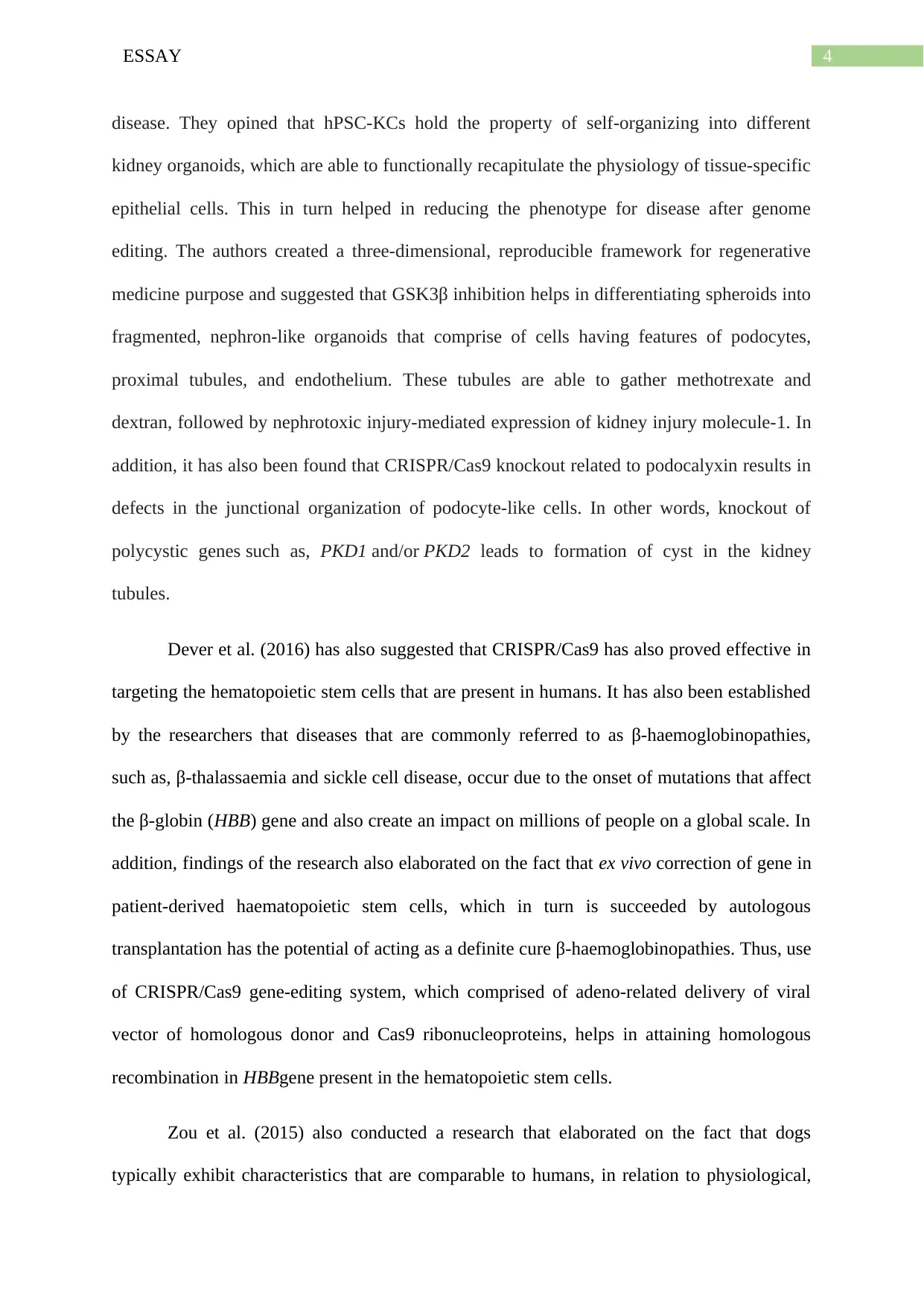
4ESSAY
disease. They opined that hPSC-KCs hold the property of self-organizing into different
kidney organoids, which are able to functionally recapitulate the physiology of tissue-specific
epithelial cells. This in turn helped in reducing the phenotype for disease after genome
editing. The authors created a three-dimensional, reproducible framework for regenerative
medicine purpose and suggested that GSK3β inhibition helps in differentiating spheroids into
fragmented, nephron-like organoids that comprise of cells having features of podocytes,
proximal tubules, and endothelium. These tubules are able to gather methotrexate and
dextran, followed by nephrotoxic injury-mediated expression of kidney injury molecule-1. In
addition, it has also been found that CRISPR/Cas9 knockout related to podocalyxin results in
defects in the junctional organization of podocyte-like cells. In other words, knockout of
polycystic genes such as, PKD1 and/or PKD2 leads to formation of cyst in the kidney
tubules.
Dever et al. (2016) has also suggested that CRISPR/Cas9 has also proved effective in
targeting the hematopoietic stem cells that are present in humans. It has also been established
by the researchers that diseases that are commonly referred to as β-haemoglobinopathies,
such as, β-thalassaemia and sickle cell disease, occur due to the onset of mutations that affect
the β-globin (HBB) gene and also create an impact on millions of people on a global scale. In
addition, findings of the research also elaborated on the fact that ex vivo correction of gene in
patient-derived haematopoietic stem cells, which in turn is succeeded by autologous
transplantation has the potential of acting as a definite cure β-haemoglobinopathies. Thus, use
of CRISPR/Cas9 gene-editing system, which comprised of adeno-related delivery of viral
vector of homologous donor and Cas9 ribonucleoproteins, helps in attaining homologous
recombination in HBBgene present in the hematopoietic stem cells.
Zou et al. (2015) also conducted a research that elaborated on the fact that dogs
typically exhibit characteristics that are comparable to humans, in relation to physiological,
disease. They opined that hPSC-KCs hold the property of self-organizing into different
kidney organoids, which are able to functionally recapitulate the physiology of tissue-specific
epithelial cells. This in turn helped in reducing the phenotype for disease after genome
editing. The authors created a three-dimensional, reproducible framework for regenerative
medicine purpose and suggested that GSK3β inhibition helps in differentiating spheroids into
fragmented, nephron-like organoids that comprise of cells having features of podocytes,
proximal tubules, and endothelium. These tubules are able to gather methotrexate and
dextran, followed by nephrotoxic injury-mediated expression of kidney injury molecule-1. In
addition, it has also been found that CRISPR/Cas9 knockout related to podocalyxin results in
defects in the junctional organization of podocyte-like cells. In other words, knockout of
polycystic genes such as, PKD1 and/or PKD2 leads to formation of cyst in the kidney
tubules.
Dever et al. (2016) has also suggested that CRISPR/Cas9 has also proved effective in
targeting the hematopoietic stem cells that are present in humans. It has also been established
by the researchers that diseases that are commonly referred to as β-haemoglobinopathies,
such as, β-thalassaemia and sickle cell disease, occur due to the onset of mutations that affect
the β-globin (HBB) gene and also create an impact on millions of people on a global scale. In
addition, findings of the research also elaborated on the fact that ex vivo correction of gene in
patient-derived haematopoietic stem cells, which in turn is succeeded by autologous
transplantation has the potential of acting as a definite cure β-haemoglobinopathies. Thus, use
of CRISPR/Cas9 gene-editing system, which comprised of adeno-related delivery of viral
vector of homologous donor and Cas9 ribonucleoproteins, helps in attaining homologous
recombination in HBBgene present in the hematopoietic stem cells.
Zou et al. (2015) also conducted a research that elaborated on the fact that dogs
typically exhibit characteristics that are comparable to humans, in relation to physiological,
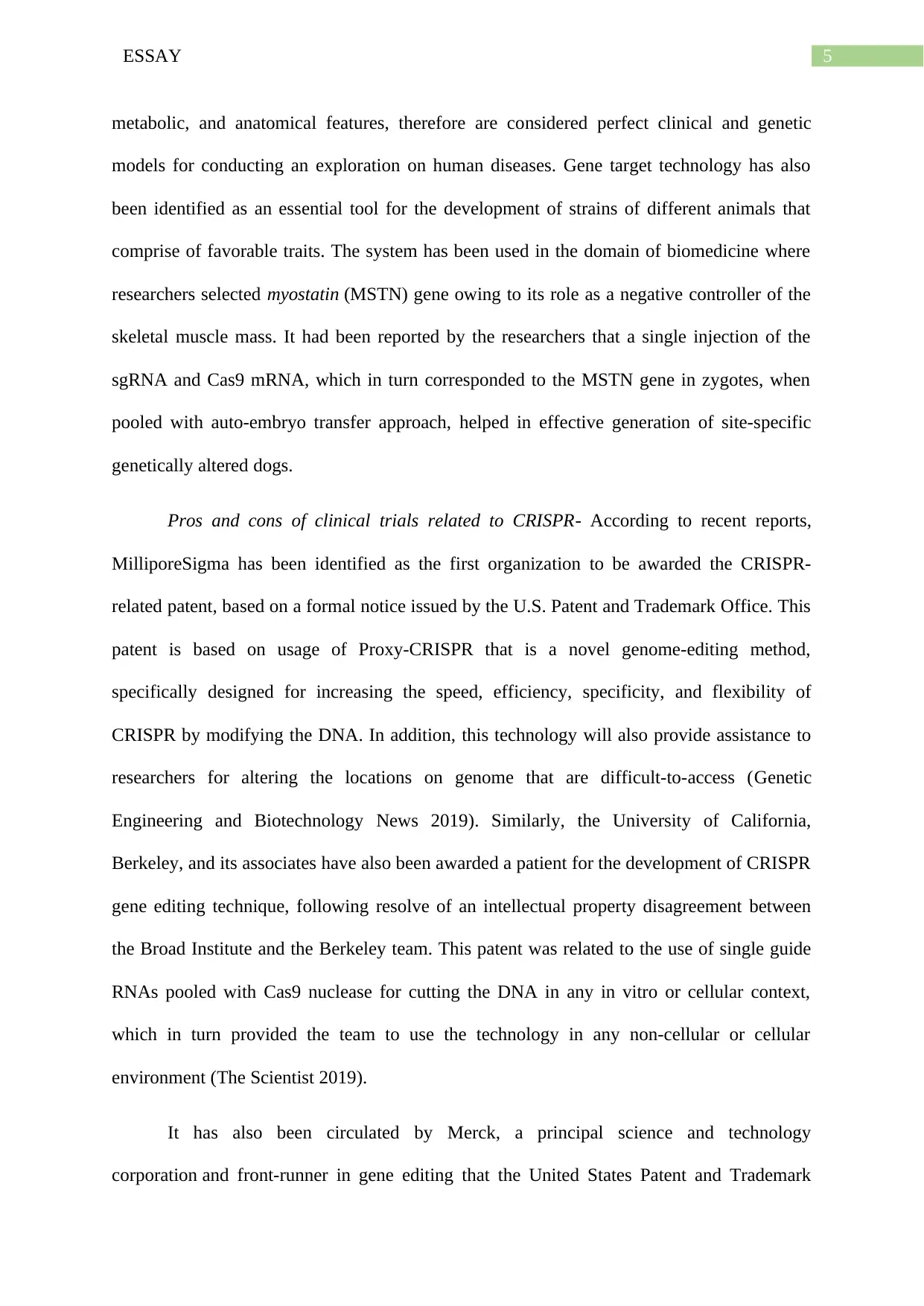
5ESSAY
metabolic, and anatomical features, therefore are considered perfect clinical and genetic
models for conducting an exploration on human diseases. Gene target technology has also
been identified as an essential tool for the development of strains of different animals that
comprise of favorable traits. The system has been used in the domain of biomedicine where
researchers selected myostatin (MSTN) gene owing to its role as a negative controller of the
skeletal muscle mass. It had been reported by the researchers that a single injection of the
sgRNA and Cas9 mRNA, which in turn corresponded to the MSTN gene in zygotes, when
pooled with auto-embryo transfer approach, helped in effective generation of site-specific
genetically altered dogs.
Pros and cons of clinical trials related to CRISPR- According to recent reports,
MilliporeSigma has been identified as the first organization to be awarded the CRISPR-
related patent, based on a formal notice issued by the U.S. Patent and Trademark Office. This
patent is based on usage of Proxy-CRISPR that is a novel genome-editing method,
specifically designed for increasing the speed, efficiency, specificity, and flexibility of
CRISPR by modifying the DNA. In addition, this technology will also provide assistance to
researchers for altering the locations on genome that are difficult-to-access (Genetic
Engineering and Biotechnology News 2019). Similarly, the University of California,
Berkeley, and its associates have also been awarded a patient for the development of CRISPR
gene editing technique, following resolve of an intellectual property disagreement between
the Broad Institute and the Berkeley team. This patent was related to the use of single guide
RNAs pooled with Cas9 nuclease for cutting the DNA in any in vitro or cellular context,
which in turn provided the team to use the technology in any non-cellular or cellular
environment (The Scientist 2019).
It has also been circulated by Merck, a principal science and technology
corporation and front-runner in gene editing that the United States Patent and Trademark
metabolic, and anatomical features, therefore are considered perfect clinical and genetic
models for conducting an exploration on human diseases. Gene target technology has also
been identified as an essential tool for the development of strains of different animals that
comprise of favorable traits. The system has been used in the domain of biomedicine where
researchers selected myostatin (MSTN) gene owing to its role as a negative controller of the
skeletal muscle mass. It had been reported by the researchers that a single injection of the
sgRNA and Cas9 mRNA, which in turn corresponded to the MSTN gene in zygotes, when
pooled with auto-embryo transfer approach, helped in effective generation of site-specific
genetically altered dogs.
Pros and cons of clinical trials related to CRISPR- According to recent reports,
MilliporeSigma has been identified as the first organization to be awarded the CRISPR-
related patent, based on a formal notice issued by the U.S. Patent and Trademark Office. This
patent is based on usage of Proxy-CRISPR that is a novel genome-editing method,
specifically designed for increasing the speed, efficiency, specificity, and flexibility of
CRISPR by modifying the DNA. In addition, this technology will also provide assistance to
researchers for altering the locations on genome that are difficult-to-access (Genetic
Engineering and Biotechnology News 2019). Similarly, the University of California,
Berkeley, and its associates have also been awarded a patient for the development of CRISPR
gene editing technique, following resolve of an intellectual property disagreement between
the Broad Institute and the Berkeley team. This patent was related to the use of single guide
RNAs pooled with Cas9 nuclease for cutting the DNA in any in vitro or cellular context,
which in turn provided the team to use the technology in any non-cellular or cellular
environment (The Scientist 2019).
It has also been circulated by Merck, a principal science and technology
corporation and front-runner in gene editing that the United States Patent and Trademark
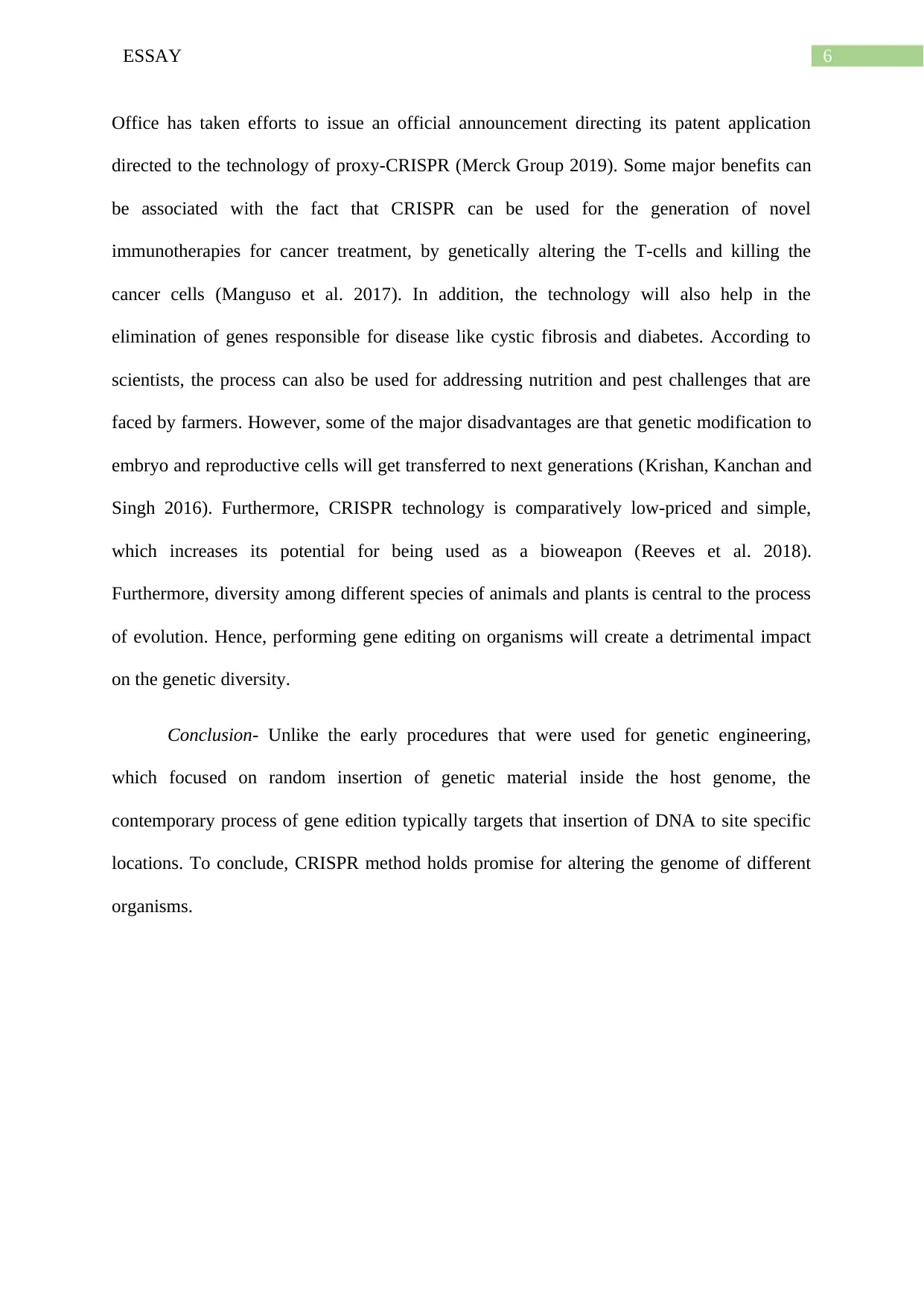
6ESSAY
Office has taken efforts to issue an official announcement directing its patent application
directed to the technology of proxy-CRISPR (Merck Group 2019). Some major benefits can
be associated with the fact that CRISPR can be used for the generation of novel
immunotherapies for cancer treatment, by genetically altering the T-cells and killing the
cancer cells (Manguso et al. 2017). In addition, the technology will also help in the
elimination of genes responsible for disease like cystic fibrosis and diabetes. According to
scientists, the process can also be used for addressing nutrition and pest challenges that are
faced by farmers. However, some of the major disadvantages are that genetic modification to
embryo and reproductive cells will get transferred to next generations (Krishan, Kanchan and
Singh 2016). Furthermore, CRISPR technology is comparatively low-priced and simple,
which increases its potential for being used as a bioweapon (Reeves et al. 2018).
Furthermore, diversity among different species of animals and plants is central to the process
of evolution. Hence, performing gene editing on organisms will create a detrimental impact
on the genetic diversity.
Conclusion- Unlike the early procedures that were used for genetic engineering,
which focused on random insertion of genetic material inside the host genome, the
contemporary process of gene edition typically targets that insertion of DNA to site specific
locations. To conclude, CRISPR method holds promise for altering the genome of different
organisms.
Office has taken efforts to issue an official announcement directing its patent application
directed to the technology of proxy-CRISPR (Merck Group 2019). Some major benefits can
be associated with the fact that CRISPR can be used for the generation of novel
immunotherapies for cancer treatment, by genetically altering the T-cells and killing the
cancer cells (Manguso et al. 2017). In addition, the technology will also help in the
elimination of genes responsible for disease like cystic fibrosis and diabetes. According to
scientists, the process can also be used for addressing nutrition and pest challenges that are
faced by farmers. However, some of the major disadvantages are that genetic modification to
embryo and reproductive cells will get transferred to next generations (Krishan, Kanchan and
Singh 2016). Furthermore, CRISPR technology is comparatively low-priced and simple,
which increases its potential for being used as a bioweapon (Reeves et al. 2018).
Furthermore, diversity among different species of animals and plants is central to the process
of evolution. Hence, performing gene editing on organisms will create a detrimental impact
on the genetic diversity.
Conclusion- Unlike the early procedures that were used for genetic engineering,
which focused on random insertion of genetic material inside the host genome, the
contemporary process of gene edition typically targets that insertion of DNA to site specific
locations. To conclude, CRISPR method holds promise for altering the genome of different
organisms.
Paraphrase This Document
Need a fresh take? Get an instant paraphrase of this document with our AI Paraphraser
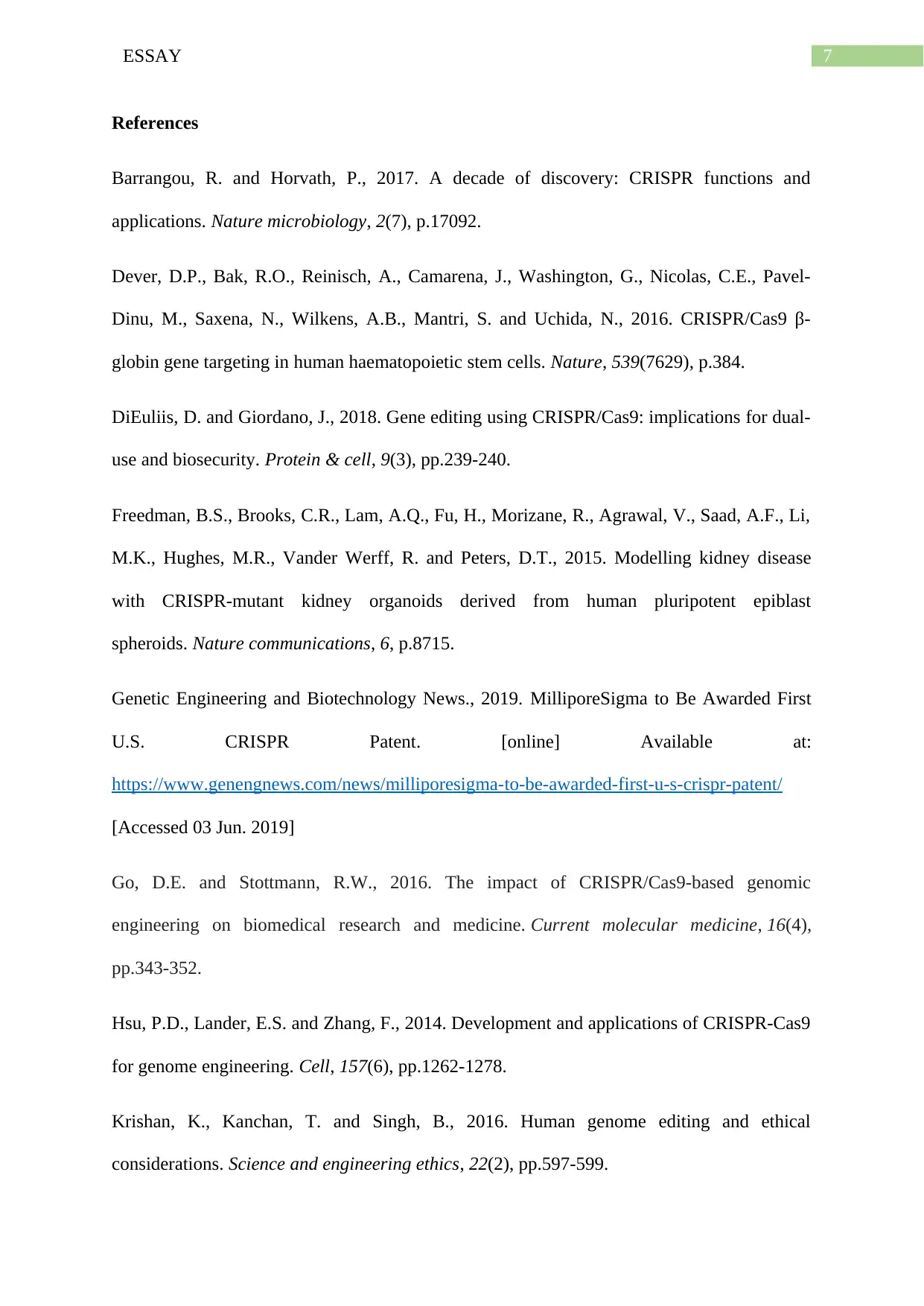
7ESSAY
References
Barrangou, R. and Horvath, P., 2017. A decade of discovery: CRISPR functions and
applications. Nature microbiology, 2(7), p.17092.
Dever, D.P., Bak, R.O., Reinisch, A., Camarena, J., Washington, G., Nicolas, C.E., Pavel-
Dinu, M., Saxena, N., Wilkens, A.B., Mantri, S. and Uchida, N., 2016. CRISPR/Cas9 β-
globin gene targeting in human haematopoietic stem cells. Nature, 539(7629), p.384.
DiEuliis, D. and Giordano, J., 2018. Gene editing using CRISPR/Cas9: implications for dual-
use and biosecurity. Protein & cell, 9(3), pp.239-240.
Freedman, B.S., Brooks, C.R., Lam, A.Q., Fu, H., Morizane, R., Agrawal, V., Saad, A.F., Li,
M.K., Hughes, M.R., Vander Werff, R. and Peters, D.T., 2015. Modelling kidney disease
with CRISPR-mutant kidney organoids derived from human pluripotent epiblast
spheroids. Nature communications, 6, p.8715.
Genetic Engineering and Biotechnology News., 2019. MilliporeSigma to Be Awarded First
U.S. CRISPR Patent. [online] Available at:
https://www.genengnews.com/news/milliporesigma-to-be-awarded-first-u-s-crispr-patent/
[Accessed 03 Jun. 2019]
Go, D.E. and Stottmann, R.W., 2016. The impact of CRISPR/Cas9-based genomic
engineering on biomedical research and medicine. Current molecular medicine, 16(4),
pp.343-352.
Hsu, P.D., Lander, E.S. and Zhang, F., 2014. Development and applications of CRISPR-Cas9
for genome engineering. Cell, 157(6), pp.1262-1278.
Krishan, K., Kanchan, T. and Singh, B., 2016. Human genome editing and ethical
considerations. Science and engineering ethics, 22(2), pp.597-599.
References
Barrangou, R. and Horvath, P., 2017. A decade of discovery: CRISPR functions and
applications. Nature microbiology, 2(7), p.17092.
Dever, D.P., Bak, R.O., Reinisch, A., Camarena, J., Washington, G., Nicolas, C.E., Pavel-
Dinu, M., Saxena, N., Wilkens, A.B., Mantri, S. and Uchida, N., 2016. CRISPR/Cas9 β-
globin gene targeting in human haematopoietic stem cells. Nature, 539(7629), p.384.
DiEuliis, D. and Giordano, J., 2018. Gene editing using CRISPR/Cas9: implications for dual-
use and biosecurity. Protein & cell, 9(3), pp.239-240.
Freedman, B.S., Brooks, C.R., Lam, A.Q., Fu, H., Morizane, R., Agrawal, V., Saad, A.F., Li,
M.K., Hughes, M.R., Vander Werff, R. and Peters, D.T., 2015. Modelling kidney disease
with CRISPR-mutant kidney organoids derived from human pluripotent epiblast
spheroids. Nature communications, 6, p.8715.
Genetic Engineering and Biotechnology News., 2019. MilliporeSigma to Be Awarded First
U.S. CRISPR Patent. [online] Available at:
https://www.genengnews.com/news/milliporesigma-to-be-awarded-first-u-s-crispr-patent/
[Accessed 03 Jun. 2019]
Go, D.E. and Stottmann, R.W., 2016. The impact of CRISPR/Cas9-based genomic
engineering on biomedical research and medicine. Current molecular medicine, 16(4),
pp.343-352.
Hsu, P.D., Lander, E.S. and Zhang, F., 2014. Development and applications of CRISPR-Cas9
for genome engineering. Cell, 157(6), pp.1262-1278.
Krishan, K., Kanchan, T. and Singh, B., 2016. Human genome editing and ethical
considerations. Science and engineering ethics, 22(2), pp.597-599.
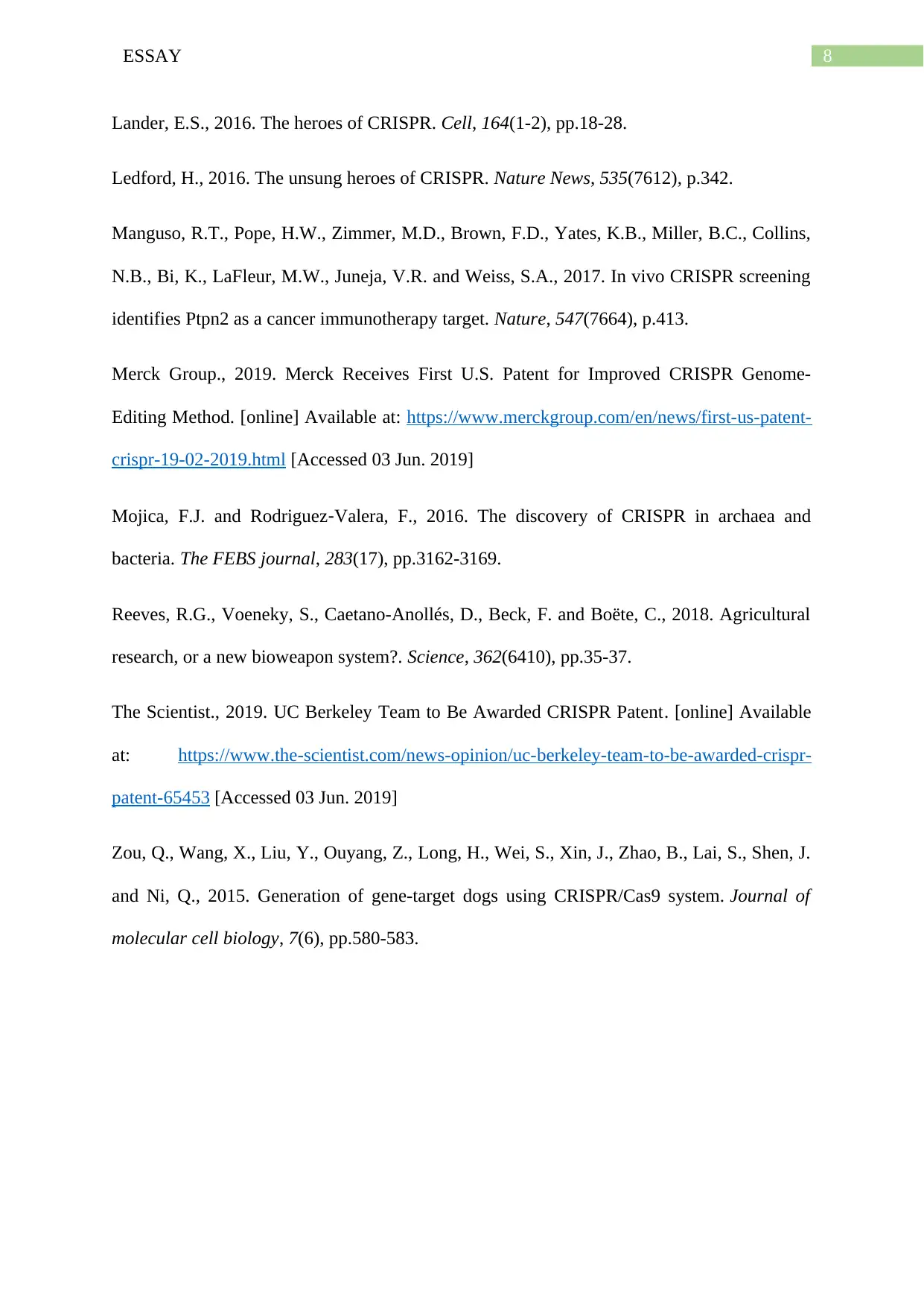
8ESSAY
Lander, E.S., 2016. The heroes of CRISPR. Cell, 164(1-2), pp.18-28.
Ledford, H., 2016. The unsung heroes of CRISPR. Nature News, 535(7612), p.342.
Manguso, R.T., Pope, H.W., Zimmer, M.D., Brown, F.D., Yates, K.B., Miller, B.C., Collins,
N.B., Bi, K., LaFleur, M.W., Juneja, V.R. and Weiss, S.A., 2017. In vivo CRISPR screening
identifies Ptpn2 as a cancer immunotherapy target. Nature, 547(7664), p.413.
Merck Group., 2019. Merck Receives First U.S. Patent for Improved CRISPR Genome-
Editing Method. [online] Available at: https://www.merckgroup.com/en/news/first-us-patent-
crispr-19-02-2019.html [Accessed 03 Jun. 2019]
Mojica, F.J. and Rodriguez‐Valera, F., 2016. The discovery of CRISPR in archaea and
bacteria. The FEBS journal, 283(17), pp.3162-3169.
Reeves, R.G., Voeneky, S., Caetano-Anollés, D., Beck, F. and Boëte, C., 2018. Agricultural
research, or a new bioweapon system?. Science, 362(6410), pp.35-37.
The Scientist., 2019. UC Berkeley Team to Be Awarded CRISPR Patent. [online] Available
at: https://www.the-scientist.com/news-opinion/uc-berkeley-team-to-be-awarded-crispr-
patent-65453 [Accessed 03 Jun. 2019]
Zou, Q., Wang, X., Liu, Y., Ouyang, Z., Long, H., Wei, S., Xin, J., Zhao, B., Lai, S., Shen, J.
and Ni, Q., 2015. Generation of gene-target dogs using CRISPR/Cas9 system. Journal of
molecular cell biology, 7(6), pp.580-583.
Lander, E.S., 2016. The heroes of CRISPR. Cell, 164(1-2), pp.18-28.
Ledford, H., 2016. The unsung heroes of CRISPR. Nature News, 535(7612), p.342.
Manguso, R.T., Pope, H.W., Zimmer, M.D., Brown, F.D., Yates, K.B., Miller, B.C., Collins,
N.B., Bi, K., LaFleur, M.W., Juneja, V.R. and Weiss, S.A., 2017. In vivo CRISPR screening
identifies Ptpn2 as a cancer immunotherapy target. Nature, 547(7664), p.413.
Merck Group., 2019. Merck Receives First U.S. Patent for Improved CRISPR Genome-
Editing Method. [online] Available at: https://www.merckgroup.com/en/news/first-us-patent-
crispr-19-02-2019.html [Accessed 03 Jun. 2019]
Mojica, F.J. and Rodriguez‐Valera, F., 2016. The discovery of CRISPR in archaea and
bacteria. The FEBS journal, 283(17), pp.3162-3169.
Reeves, R.G., Voeneky, S., Caetano-Anollés, D., Beck, F. and Boëte, C., 2018. Agricultural
research, or a new bioweapon system?. Science, 362(6410), pp.35-37.
The Scientist., 2019. UC Berkeley Team to Be Awarded CRISPR Patent. [online] Available
at: https://www.the-scientist.com/news-opinion/uc-berkeley-team-to-be-awarded-crispr-
patent-65453 [Accessed 03 Jun. 2019]
Zou, Q., Wang, X., Liu, Y., Ouyang, Z., Long, H., Wei, S., Xin, J., Zhao, B., Lai, S., Shen, J.
and Ni, Q., 2015. Generation of gene-target dogs using CRISPR/Cas9 system. Journal of
molecular cell biology, 7(6), pp.580-583.
1 out of 9
Related Documents
Your All-in-One AI-Powered Toolkit for Academic Success.
+13062052269
info@desklib.com
Available 24*7 on WhatsApp / Email
![[object Object]](/_next/static/media/star-bottom.7253800d.svg)
Unlock your academic potential
© 2024 | Zucol Services PVT LTD | All rights reserved.





